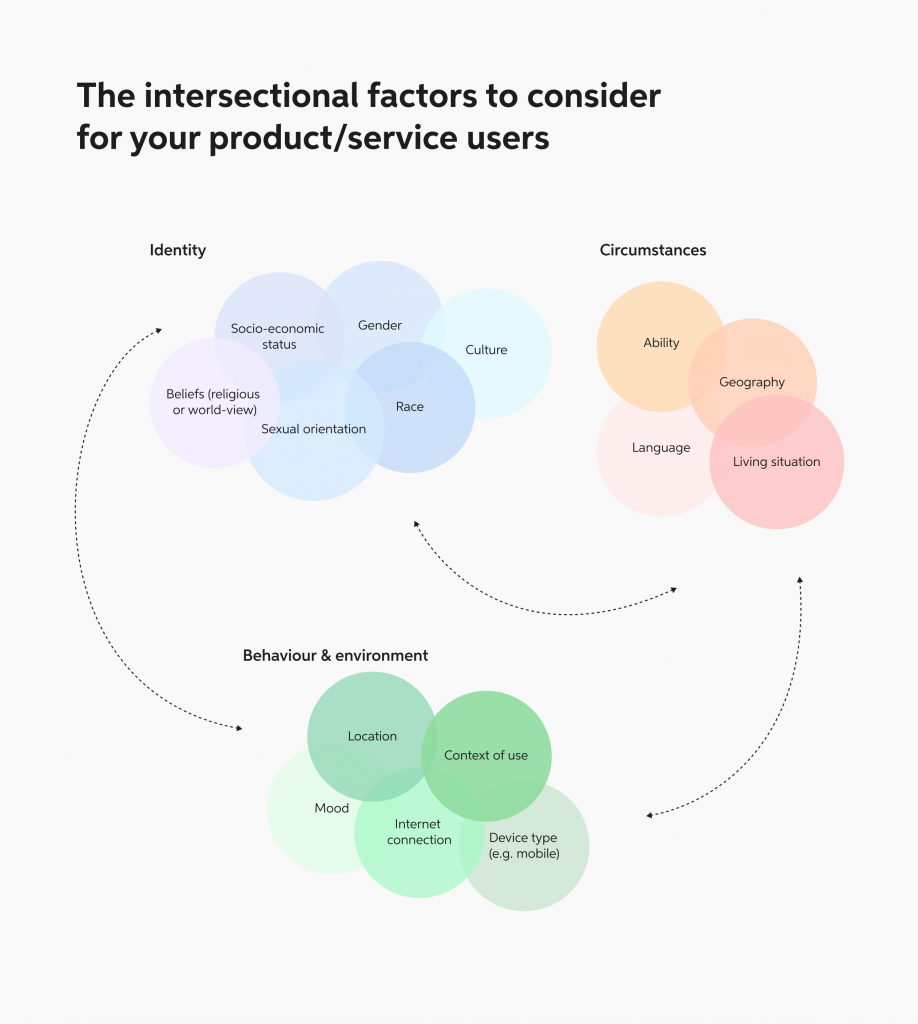Our article Intersectionality: a critical piece of your service and product strategy by Lee Dale and Kate Matesic, is now published in UX Magazine, August 10, 2020.
People, and the frameworks we use for understanding people, are at the heart of effective strategy and design work.
We’ve previously explored how there is no average person, which makes it challenging to use personas and archetypes to qualify an audience or user.
Why is it so difficult to group people together?
Because driving our inherent complexity is the intersectionality and fluidity of who we are.
People are complex & fluid
Often when designers or strategists talk about people or users, there’s a tendency to assume that people fit into neat, one-size-fits-all boxes that describe behaviour and experiences universally within that group. For instance, you might hear a product team talk about how something could work better for new moms, or for people from New York who don’t like pizza, or for basketball fans who visit a site once a week.
It’s not that simple, however, to understand the human complexities that make up your audience or user base. There are so many identities, circumstances, and fluid behaviours that influence your users, on a moment-to-moment basis, and on a longer-term basis.
Thinking back to our example of a new mom
How might a mother vulnerable to migraines be affected by their pain on any given day?
What about mothers who home school? If they are the only parent? Or have a nanny?
Or a mother from an underrepresented community? Or is a recent immigrant?
Who may have a higher income? Who recently lost their job?
In this case, these could be traits of 8 different new moms or, together, this could describe one mom. Is your team considering all of these factors? How might acknowledging these traits and who they represent bring more clarity to your service planning and product strategy?
All of the individual factors that make up identity and user contexts are most influential when we think about how they combine to influence how someone engages with products and services.
A concept called intersectionality is a better way of looking at all of the factors that can influence the use of your products and services.
What is intersectionality?
Intersectionality is a way of thinking through how factors of identity (gender, race, sexuality, class, and many more) interact with one other and form a clearer picture of who someone is.
In understanding how these factors combine, we can more deeply understand an individual user’s priorities and context of use.
Another area that is important as part of intersectional thinking is the concept of fluidity. Factors including culture, geography, mood, behaviour, abilities (temporary and permanent), different devices, and internet connections are circumstantial or ever-changing influences on user needs and behaviour.
Since many of these areas are constantly shifting (abilities, mood, place, devices), even a snapshot of who we are at this moment isn’t necessarily representative of us on any given day.

Intersectional factors to consider for your users
Identity
- Race
- Culture
- Gender
- Socio-economic status
- Sexual orientation
- Beliefs (religious or world-view)
Circumstances
- Ability
- Language
- Living situation
- Geography
Behaviour & environment
- Mood
- Location
- Context of use
- Geography
- Device type (e.g. mobile)
- Internet connection
These factors, and infinite other factors, shape how users behave and perceive interactions, alongside their identities, and are a crucial piece of a more comprehensive lens for viewing your users and other stakeholders.
How intersectionality influences design and strategy work
Intersectionality, user contexts, and an understanding of the fluidity of your users should form the backbone of all of the human-centred design and strategy work you undertake, whether you’re looking to improve an existing product or service or create a new one.
In general, consider that any time you want to group people, no matter how you categorize them, whether, by race, age, behaviour, interests, or any other grouping of factors, every person in that group may be different across any number of other factors.
Your team may typically leverage tools like marketing personas to build out your design or product requirements. However, personas and similar generalizations aren’t well suited to the complexity of your users.
There are many other methods you can use to go beyond personas when you’re looking to engage authentically with people. These can include user states and context maps, Jobs-to-be-done (JTBD), and user stories.
Learn more about going beyond personas
The impact of intersectional thinking
Making strategy and design decisions with intersectionality at the forefront will guide your team in identifying genuinely user-centric design requirements.
Once you establish these requirements, your product or service will be able to meet the goals and expectations of your users across different circumstances, contexts, and environments, and to embrace their unique identity.
By understanding how all of these factors mix and interact to form the experiences of your users, you can design your products and services in a much more intentional way. Ultimately, this means delivering products and services that can be used and loved by a much broader market, while improving the experience for your existing users as well.
Not sure how to get started with an intersectional, inclusive design process?
From our inclusive public sector work to our insurance, banking, and other private sector work, we continue to develop our inclusive design practice and bring impactful service design and product strategy outcomes to the organizations and communities we work with.